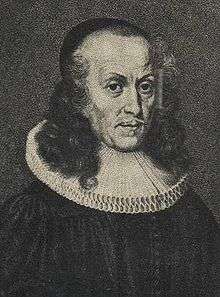Peter Spaak
Peter Spaak (1696-1769) was a Swedish Protestant reformer, and founder of the society of Pietists based in Uddevalla, Diocese of Gothenburg, part of which was later integrated into the Church of Sweden.[1]
Biography
Peter Spaak was born 1696 in Uddevalla, Bohuslän, Sweden. His father Elias Jonæ Spaak served as the local Postmaster and Deputy Customs Chief Inspector, and his maternal grandfather was the Chief Judge Johan Larsson Crantzberg. Peter Spaak's brother Magnus Spaak (1699–1768) emmigrated to Brussels, Belgium, becoming the primogenitor of the family cadet branch there.
Peter Spaak was married twice. The first time was to Clara Charlotta Esberg, the sister of Zacharias Esberg the Younger, the Vicar of Uddevalla, and niece of Bishop Jacob Berzelius of Gothenburg. His second marriage was to Ingrid Maria Bagge, daughter of Eva Christina Rahde Palmencrona, and great granddaughter of Nils Fredriksson Bagge, Mayor of Marstrand.
Professionally, Spaak served as Chief Inspector of the Customs service, and Postmaster in Uddevalla.
Influenced by the pietism of the German theologian Johann Conrad Dippel, along with Thomas Leopold and Johan Stendahl, Peter Spaak became one of the most prominent early proponents of the movement in Sweden.[2] Originally, the new ideas were met with much opposition, culminating in the Conventicle Act in 1726. Like Leopold and Stendahl, at one time Spaak was threatened with prison sentence for heresy. However, contrary to the fate of the former two he was eventually relieved of the allegations, attributed to his contacts with the authorities.
The movement gained significant influence throughout the Diocese of Gothenburg, with Spaak establishing a society based in Uddevalla. Several of his family members and relatives followed suit.[3]
For a period from 1734 onwards, Spaak resided in Stockholm, where he came in contact with the Skevikare radicals. Around this time, Riksdag meetings evaluated the influences of Pietism in the realm, having gained supporters also among mainline Protestant clergy,[1] with Spaak and others advocating freedom of religion.
With time being, after initial criticism by the state authorities against the perceived cultural radicalism of the partially dissident movement, resistance was relaxed and it was eventually reevaluated as a legitimate expression of Lutheranism.
Peter Spaak died 1769 in Gothenburg.
Legacy
Subsequent to the great fire of Uddevalla in 1806, a stone house was erected for the Pietist adherents, which gave the street block its name, Herrnhut. The building, later purchased by the municipality, remained until another fire in the 1980s.[4]
After having met growing acceptance by mainstream Protestant society, in the mid-19th century, a part of the Pietist movement was fully integrated into the official Evangelical-Lutheran Church of Sweden,[5] although another part would persist in Radical Pietist deference into a Uddevalla local predecessor of the state independent Protestant Uniting Church in Sweden.
See also
References
- 1 2 "251 (Religionstvång och religionsfrihet i Sverige 1686-1782. Bidrag till den svenska religionslagstiftningens historia)". runeberg.org. 14 September 1896. Retrieved 14 September 2018.
- ↑ "Jacob Benzelius". sok.riksarkivet.se. Retrieved 14 September 2018.
- ↑ "Carl August Kullgren". sok.riksarkivet.se. Retrieved 14 September 2018.
- ↑ Uddevalla Missionsförsamlings 100-årsskrift (1978)
- ↑ "Om oss - Evangeliska Brödraförsamlingen". Retrieved 14 September 2018.
